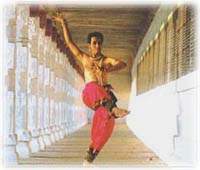Home » Information » Culture » BharataNatyam
BharataNatyam
Bharatanatyam is a classical dance form believed to be originated in
Thanjavoor of Tamil Nadu in South India. As it was performed by Devadasies in
temples of Tamil Nadu long ago it is also known as Dasiyattam. Basic concepts
of 'Bharatanatyam' are Bhava, Raga and Thaala.Bharatanatyam derives its origin
based on the theories posted in the books 'Natyasaasthram' and 'Abhinaya
Darpanam'. Bharatanatyam is evenly divided between three elements Nritta,
Nritya and Natya .
Nritta : Rhythmic Element. Interprets the language of rhythm with the
help of body movements.
Nritya : Combination of Rhythm with expression conveys poetic meaning
with the help of expressions, rhythmic postures. eg. Varna, Shabda, Pada etc.
Natya : Dramatic Element. Performing for a theme like Ramayana,
Mahabharata etc
|

|

|
Nritta can be broadly divided into Chari, Karana, Angahara and Mandala.
Movement of a leg is called Chari. Movement of both the legs is Karana. 3
Karanas make a Khanda.3 to 4 Khandas make a Mandala. 4 to 9 Karanas make a
Angahara. 4 to 5 Angaharas also make a Mandala. 108 Karanas and 32 Angaharas
are defined in Natyashatra. The 13 Nritta Hastas (explained later) are used to
perform nritta. The rythmic body movements along with hand gestures are called
Aduvus. Number of aduvus constitute a Jati
|
Jati will generally end with a Muktaya or Teermana. There are varieties of
Aduvus like Tattaduvu ,Mettaduvu, Nataduvu,Kattaduvu, Kudittamettaduvu ,
Maiaduvu, Mandiaduvu ,Jati ,Nadai ,Ardi .The entire body is divided as Anga,
Pratyanga and Upaanga. Anga Lakshana, the way of moving body parts, are
described as: Shirobhedha - Head Movement , Greevabhedha - Neck Movement,
Drushtibhedha - Eye Movement , Paadabhedha Mandala - Standing Posture ,
Utplavana - Leaps, Bhramari - Circling Movement ,Chari - Leg Movement,
Gatibhedha - Charecteristic walks and Hastas or Mudras - Hand Movements
-Asamyuta Hasta ,Samyuta Hasta ,Deva Hasta ,Dashavatara Hasta , Navagraha Hasta
,Jaati Hasta,Bandhu Hasta , Nritta Hasta .When all Angas(main body parts)
coordinate (along with pratyanga and upaanga) the artist is said to have
Angashudhi. Anga meaning body parts and shudhi, meaning perfect. Any dancer
should try to achieve this perfection. The Natyashastra, which talks about all
aspects of Bharatanatyam, quotes shlokas to perform all the above movement.
Arangetram is a tamil word. Aranga meaning raised floor and Etram meaning
climbing in Tamil, one of the south Indian languages. It is also called
Rangapravesha in Kannada, another south Indian language, Ranga meaning Stage
and Pravesha meaning Enter. Ideally this should be the first public performance
of an artist. After learning Bharathanatyam under the guidance of an
accomplished guru, this is the occasion for the proud guru to present his/her
disciple to the public. This is the testing time for both the guru & the
shishya (disciple) as the guru's knowledge & the disciple's talent both are
judged by the public. Hence, the guru will decide when the disciple is ready
for public appearance. At least 10 - 12 years of training is necessary to give
a commendable performance. Usually duration of an Arangetram will be 2 1/2 - 3
hours. To perform for such long hours one must have good stamina and
concentration. This time is divided into two halves. In the first half the
artists generally perform Pushpanjali or Alaripu ,Jatiswara, Shabda, Varna In
the second half Padam ,Ashtapadi or Devaranama, Tillana , Mangala .
|
|